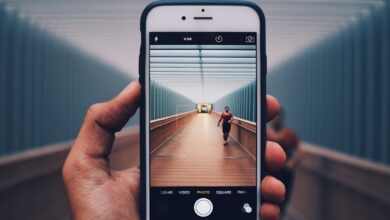The Psychology of Phone Formatting Habits

Have you ever wondered why some people meticulously organize their phone apps while others have a digital chaos on their screens? The psychology behind phone formatting habits reveals interesting insights into human behavior and personal preferences. In this article, we will delve into the factors that influence how we format our phones and shed light on the meaning behind these habits.
One key aspect that affects phone formatting is individual personality traits. Just as some individuals prefer a tidy physical environment, they extend this preference to their digital world. These people often create folders to categorize their apps based on functionality or themes, allowing for easy navigation and access. On the other hand, those who embrace a more spontaneous and carefree approach might opt for a cluttered screen, where every app is just a swipe away. Their fluidity with technology enables them to find what they need amidst the apparent disorder.
Cognitive load also plays a significant role in phone formatting habits. Our brains naturally seek simplicity and efficiency, and organizing our phones in a way that minimizes cognitive effort is a subconscious goal. By arranging frequently used apps on the home screen or utilizing smart folders, individuals reduce the mental strain associated with searching for specific applications. This streamlined approach enhances productivity and reduces decision fatigue, allowing for a smoother user experience.

Moreover, cultural and societal influences contribute to phone formatting habits. Different cultures emphasize various values, such as orderliness or creativity, which can manifest in digital habits. For example, in cultures that prioritize structure and discipline, individuals are more likely to maintain a neat and organized phone layout. Conversely, societies that celebrate individualism and personal expression may witness a greater diversity of formatting styles, reflecting their members’ unique identities.

The psychology behind phone formatting habits offers a fascinating glimpse into the intricacies of human behavior and personal preferences. Whether driven by personality traits, cognitive load considerations, or cultural influences, the way we format our phones reflects our desire for efficiency, self-expression, or simply a touch of digital spontaneity. Next time you glance at someone’s phone screen, take a moment to appreciate the underlying psychology behind their formatting choices and consider what it reveals about their individuality.
Unraveling the Mind: The Surprising Psychological Factors Behind Phone Formatting Habits
Have you ever wondered why we feel the need to organize and format our phones in specific ways? It turns out that there are fascinating psychological factors at play behind our phone formatting habits. Let’s dive into this intriguing topic and uncover the hidden motivations behind our digital organizational tendencies.
One key factor influencing phone formatting habits is the need for control. Our lives can often feel chaotic and overwhelming, but organizing our phones allows us to regain a sense of order and structure. By arranging apps into folders or placing them on specific screens, we create a visual representation of control over our digital environment.
Additionally, our formatting choices can reflect our personality traits. Some individuals prefer minimalist layouts with only essential apps visible, while others enjoy a more eclectic arrangement with widgets, wallpapers, and personalized themes. These choices can provide insights into our preferences for simplicity or creativity, revealing aspects of our character and style.
Another surprising psychological factor is the desire for efficiency. We seek to optimize our phone usage by placing frequently used apps within easy reach or categorizing them based on functionality. This behavior stems from our innate inclination to streamline processes and maximize productivity—a reflection of our modern, fast-paced lifestyles.
Moreover, our phone formatting habits can be influenced by social norms and trends. We often mimic the organization patterns of our peers or adopt popular home screen aesthetics showcased on social media platforms. It’s fascinating to observe how collective preferences shape our individual choices, further highlighting the power of social influence in our digital lives.
The psychology behind phone formatting habits goes beyond mere aesthetics. It involves the fundamental human needs for control, self-expression, efficiency, and conformity. By understanding these underlying factors, we gain a deeper comprehension of ourselves and the intricate relationship we have with our digital devices. So, next time you arrange your phone icons or customize your wallpaper, take a moment to reflect on the psychological motivations behind your choices.
From Cluttered Chaos to Minimalistic Bliss: The Fascinating Psychology of Phone Formatting
Are you tired of constantly searching through a sea of app icons and notifications on your phone? Do you long for a sense of order and simplicity in the digital world? If so, then it’s time to delve into the fascinating psychology of phone formatting. By understanding the underlying principles behind minimalistic bliss, you can transform your cluttered chaos into a streamlined and efficient digital experience.
In today’s fast-paced world, our smartphones have become an extension of ourselves. They hold our memories, connect us with loved ones, and provide endless sources of information. However, this constant influx of data can quickly overwhelm us and hinder our productivity. That’s where phone formatting comes in.

Phone formatting refers to the art of organizing your device’s interface to maximize functionality and minimize distractions. It involves decluttering your home screen, arranging apps into logical folders, and customizing settings to suit your needs. But why does this matter? And how does it affect our psychology?
Firstly, a cluttered phone interface bombards our brains with visual noise. Countless studies have shown that visual clutter increases stress levels and impairs cognitive function. When we’re presented with a disorganized array of icons and notifications, our attention becomes fragmented, leading to decreased focus and productivity.

On the other hand, a well-formatted phone interface promotes a sense of calm and control. By decluttering and simplifying our screens, we create a visual environment that is easier to navigate and process. This, in turn, reduces cognitive load and frees up mental resources for more important tasks.
Moreover, phone formatting can be seen as an expression of personal identity. Just like our physical surroundings, our digital spaces reflect who we are. By curating our apps, wallpapers, and themes, we shape our phone’s aesthetics to align with our preferences and values. This self-expression boosts our satisfaction and emotional well-being, creating a positive feedback loop of minimalistic bliss.
The psychology of phone formatting goes beyond mere aesthetics. It influences our mental state, productivity, and emotional well-being. By embracing minimalism and organizing our digital lives, we can unlock a world of simplicity and efficiency. So, take a deep breath, grab your phone, and embark on a journey from cluttered chaos to minimalistic bliss. Your mind will thank you.
The Hidden Meaning Behind Your Phone’s Layout: How Formatting Choices Reflect Personality
Have you ever stopped to wonder why your phone’s layout is the way it is? The arrangement of icons, widgets, and shortcuts may seem like just a matter of personal preference or convenience. However, there’s actually a hidden meaning behind your phone’s formatting choices that can reflect aspects of your personality. Let’s delve into this intriguing topic and uncover the secrets of how your phone layout can reveal more about who you are.
One of the key elements to consider is the home screen setup. Are you someone who likes a clean and minimalist look with only a few essential apps displayed prominently, or do you prefer a crowded home screen filled with numerous icons and widgets? This choice can provide insights into your organizational skills and your approach to prioritizing tasks. A cluttered home screen might suggest a multitasker who thrives in chaos, while a minimalistic layout could indicate a preference for simplicity and a desire for a streamlined user experience.
The choice of wallpaper on your phone also speaks volumes about your personality. Whether it’s a striking photograph, a serene landscape, or an abstract design, your wallpaper reflects your aesthetic taste and emotional preferences. A vibrant and colorful wallpaper might denote an outgoing and extroverted personality, while a serene nature scene could indicate a calm and introspective disposition.
Another aspect to consider is the arrangement of app icons. Do you meticulously organize them into folders and categories, or do you leave them scattered across multiple screens? Those who prefer a well-organized system demonstrate a meticulous and detail-oriented nature. They value efficiency and enjoy having quick access to specific apps. On the other hand, individuals with a more haphazard arrangement may embrace spontaneity and have a flexible approach to life.
Furthermore, the choice of widgets can offer further insights into your personality traits. Are you drawn to weather widgets, news updates, or fitness trackers? These choices reflect your interests, priorities, and areas of focus in your daily life. A weather widget enthusiast may be someone who values preparedness and likes to stay informed, while a fitness tracker user might indicate a health-conscious and active lifestyle.
Cracking the Code: Decoding the Intriguing Psychology of Phone Organization
Are you tired of constantly searching for your apps amidst a sea of icons on your phone? Do you find yourself longing for a simpler, more organized digital life? Well, you’re not alone. The psychology behind phone organization is a fascinating subject that has captivated many tech enthusiasts and psychologists alike. In this article, we will delve into the depths of this intriguing topic and uncover the secrets to cracking the code of phone organization.
Let’s start by asking ourselves: why do we even bother organizing our phones in the first place? The answer lies in our innate desire for efficiency and convenience. Just like a cluttered desk can hinder productivity, a disorganized phone can impede our ability to navigate through our digital lives smoothly. By arranging our apps and files in a logical manner, we gain quick access to the tools and information we need, ultimately saving valuable time and energy.
So, how do we go about decoding the psychology of phone organization? One approach is to consider the principles of cognitive psychology. Our brains are wired to seek patterns and create mental shortcuts. When it comes to our phones, we instinctively categorize apps based on their functions. For example, we might group social media apps together or organize productivity tools in a separate folder. By doing so, we tap into our cognitive processes and make it easier for our brains to locate specific apps when needed.
Phone organization also taps into our emotional well-being. Think of your phone as a personal sanctuary, a reflection of your identity and preferences. Just as we arrange physical spaces to create a sense of harmony, we do the same with our digital environments. By customizing our wallpapers, selecting aesthetically pleasing app icons, and creating visually appealing layouts, we infuse our phones with personality, making them an extension of ourselves.

The art of phone organization goes beyond mere practicality. It intertwines with our cognitive processes and emotional attachment to technology. By understanding the psychology behind it, we can unlock the potential for a more efficient and personalized digital experience. So, take a moment to assess your phone’s organization and see if you can crack the code to a more streamlined and captivating mobile life.




